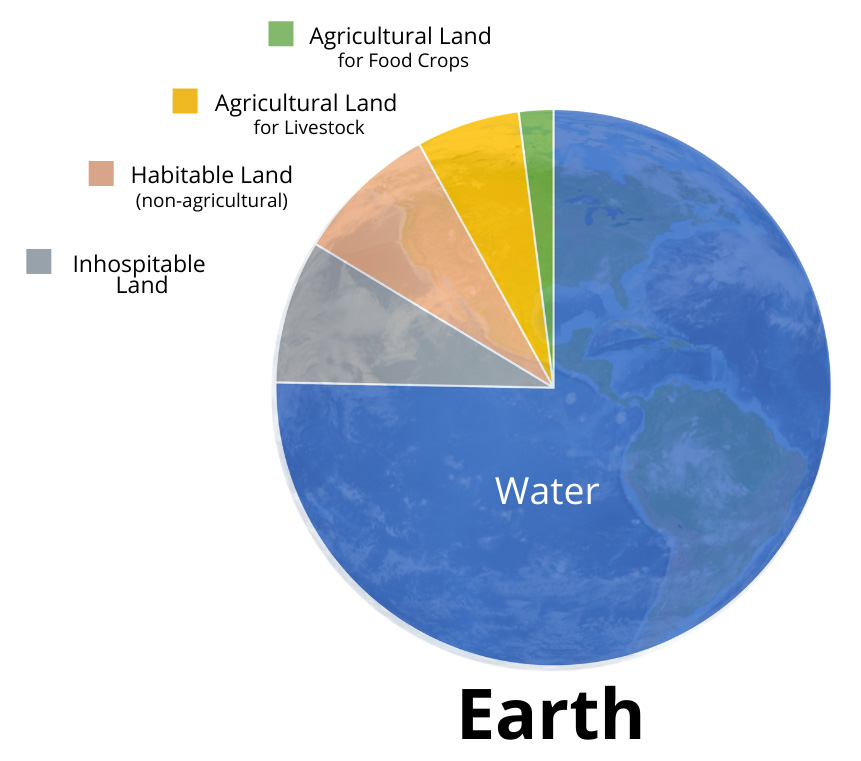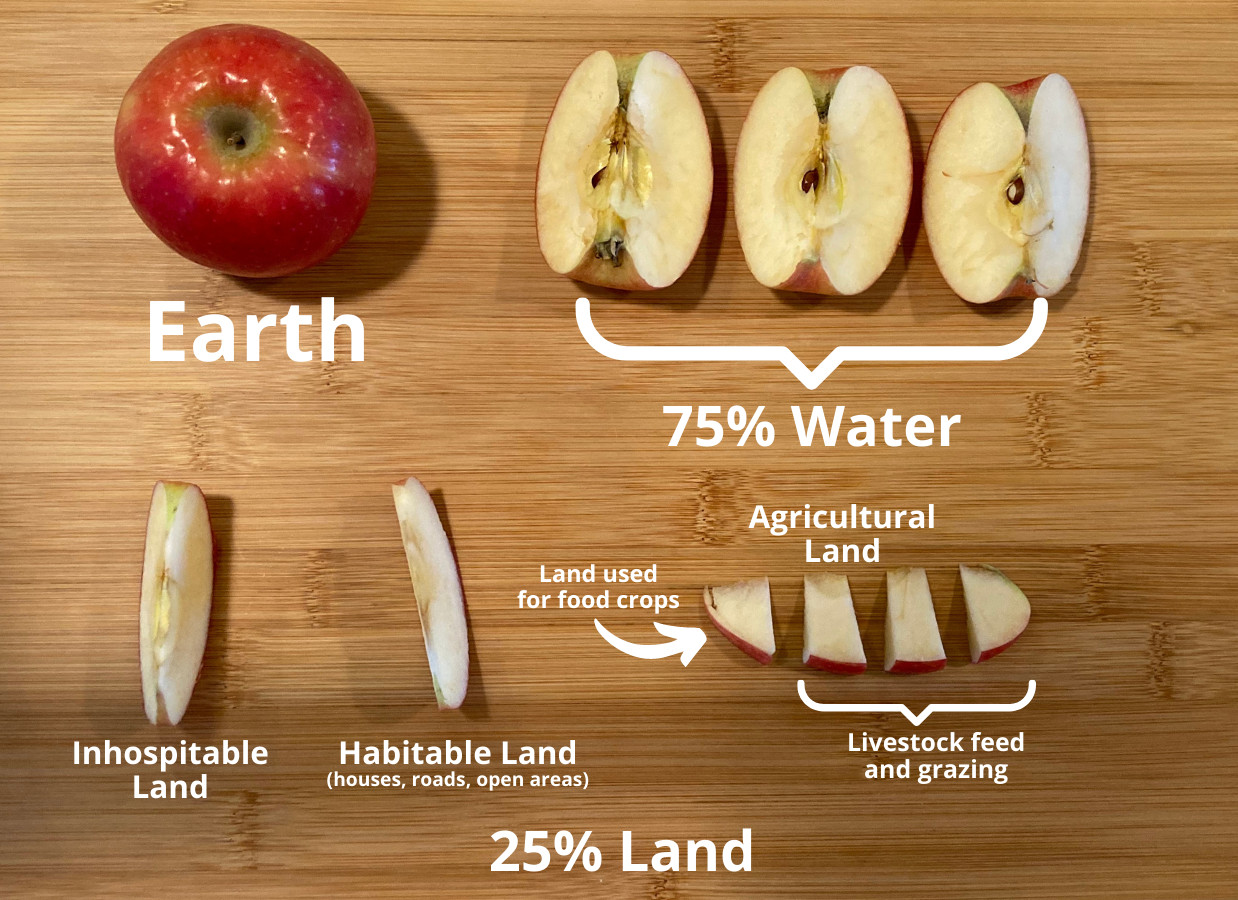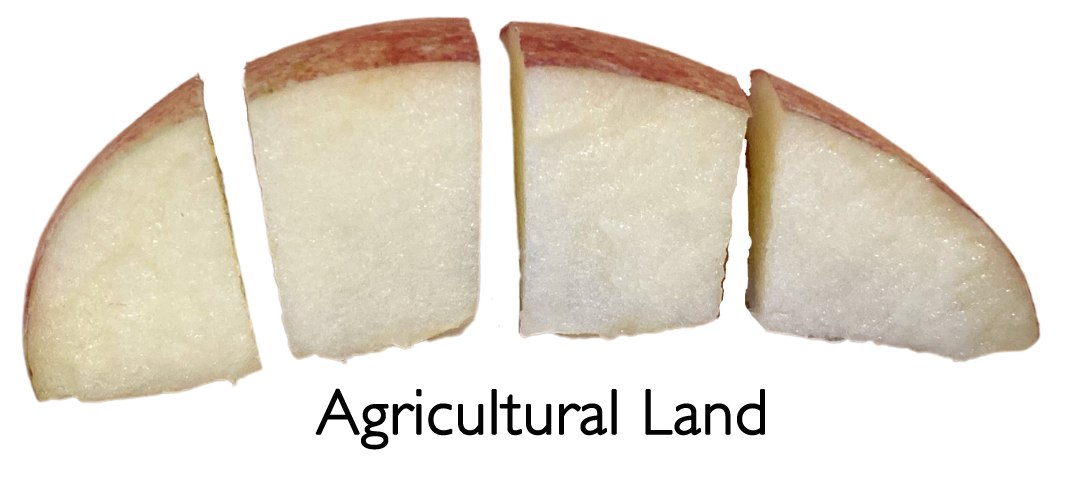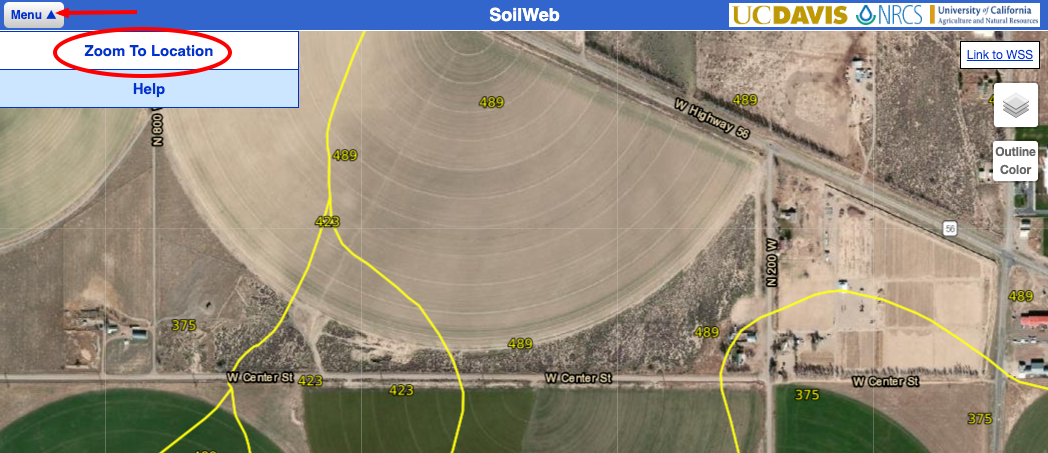 Relevancy and Engagement
newmexico.agclassroom.org
Relevancy and Engagement
newmexico.agclassroom.org
Earth's Land and Soil Resources
Grade Level
Purpose
Students discover that topsoil is a nonrenewable resource and use an apple to represent how Earth’s land resources are used. Through critical thinking, students study agricultural land use and consider the sustainability of current land use practices including the use of land to feed and graze livestock animals. Grades 9-12
Estimated Time
Materials Needed
Engage:
- Nonrenewable Resource image to project
- Let's Talk About Soil video
Activity 1: Slicing Up Earth's Land Resources
- Large apple
- Knife
- Cutting Board
- Optional Alternative: Apple Land Use Model, available for purchase from agclassroomstore.com
- Slicing Up Earth's Land Resources activity sheet
- Slicing Up Earth's Land Resources slide deck
Activity 2: The Value of Topsoil
- Agricultural Land Apple Slice image to project
- The Value of Soil handout, 1 copy per student
Activity 3: Breaking Down Agricultural Land Use
- Agricultural Land Apple Slice image to project
- Eating Less Meat Won't Save the Planet. Here's Why video clip
Vocabulary
conservation tillage: farming methods that reduce the intensity or frequency of tilling in order to maintain some ground cover throughout the year and disturb the soil as little as possible while still providing the conditions needed to grow a productive crop
nonrenewable resource: limited natural resource that cannot be replaced or reproduced within a generation and cannot be managed for renewal; examples include oil, soil, mineral resources (lead, iron, cobalt, zinc, etc.)
sustainable agriculture: an approach to agriculture that focuses on producing food while improving the economic viability of farms, protecting natural resources, and enhancing quality of life for farmers and society as a whole
value: usefulness or importance of something; also, the amount of money that something is worth
Did You Know?
- Soils are home to a quarter of Earth's species.1
- One gram of soil can harbor up to 10 billion organisms—more than the number of people on the earth.1
- 95% of food production relies on the soil.1
- Soils store more carbon than the atmosphere making them an important weapon in the fight against climate change.1
Background Agricultural Connections
Agricultural Land Use

While the world population is growing, the size of our Earth and the natural resources that provide for our needs are not. How much arable land do we have on Earth to produce our food? How much land is located in climates that are habitable? What does land use in agriculture look like today? Oceans and other water bodies cover approximately 75% of our Earth leaving 25% land. Not all land is created equal. Polar regions, deserts, salt flats, and exposed rock make up one third of global land area. These areas are considered inhospitable and are not suitable for people to live or produce food. Two thirds of our land is habitable. It is located in climates where people can live and where they produce their food. Half of the world's habitable land is covered in houses, cities, roads, and other developments. The remaining half of all habitable land is used for agriculture.2
To further examine agricultural land use, 25% of agricultural land is used to produce food crops for direct human consumption. This includes the production of fruits, vegetables, beans, rice, grains, etc. The remaining 75% of agricultural land is used to feed livestock such as cattle, pigs, poultry, sheep, and goats. Livestock are raised throughout the world for meat, milk, and eggs. Livestock land use includes range and pasturelands used for grazing as well as croplands used to grow grain commodities that are fed to livestock (rather than people). Why is there an uneven distribution of agricultural land devoted to foods for direct human consumption compared to the land devoted to feeding livestock? To explore this topic it is important to understand that cattle, sheep, and goats are ruminants. They have unique digestive systems that allow them to digest and gain nutrients from grasses and other forages that humans (and most other animals) cannot. 86% of global livestock feed intake in dry matter consists of feed materials that are not edible for humans.3 The average life cycle of beef cattle in the United States is 18-22 months.4 Cattle generally live and graze on pastures and rangelands until the last four to six months of their life when they are moved to a feedlot where they are fed harvested forages and high concentrate grains until harvest.4 Grazing animals can convert many otherwise unusable plants and by-products to quality protein. Grazing is especially vital in arid regions of the world where water is insufficient for the growth of other crops.5 These marginal lands can be considered low value due to poor soil, steep terrain, low water availability or other undesirable characteristics. Could land used to graze livestock be converted to cropland? Yes, but not all. Livestock use 2 billion hectares of land for grazing, of which 700 million hectares (35%) could be used as cropland.3
In addition to grazing, livestock animals also require feed in the form of cereal grains. Examples include field corn, soybeans, barley, oats, sorghum, and others. Grain-based feeds are fed to beef cattle in the feedlot, to dairy cattle during milk production, and to poultry and pigs that convert thier feed into other protein-based foods for humans.
The Value of Soil
There are many factors to consider in determining how land can be used. Climate, topography, and available natural resources are a few. One natural resource that is critical to agricultural land use is topsoil—the upper, outermost layer of soil. Whether the land is producing food crops, grazing livestock, or producing crops for livestock feed, it must have fertile topsoil. Agriculture depends on good soil. Fertile topsoil produces the highest yields of food per acre. Farmers will work hard to protect their soil. However, erosion and other forms of soil loss can be complicated and expensive to address.
Soil is composed of both living (biotic) and nonliving (abiotic) elements. Soil contains air, water, and minerals as well as plant and animal matter. Soil is formed by the disintegrating of rock under the influence of climate. Events such as temperature fluctations (freezing and thawing) contribute to the weathering of rock into the substance we recognize as soil. Organic matter such as leaves, dead plant material, and decaying organisms contribute to the biotic components of soil.
It can take 100 to 500 years to make one inch of topsoil. From the perspective of a human lifetime, soil is a nonrenewable resource. In the United States, cropland erosion decreased by more than 40% between 1982 and 2007. During this time, more and more farmers implemented practices like strip cropping, contour planting, conservation tillage, and planting cover crops to help mitigate wind and water erosion. Erosion has slowed over the past 30 years, but we are still losing millions of tons of topsoil each year at a rate much faster than the natural replenishment rate. Farmers don’t always have the resources needed to implement soil conservation practices. For example, cover crops effectively reduce erosion, but the seed for the crop costs money, takes time to plant, and needs water to grow, and the cover crop doesn’t directly generate any income for the farmer. When topsoil is lost, crops are less productive, income is reduced, fewer people might be fed, and sediment may wash into lakes and rivers downstream impacting water quality.
Erosion reduces agricultural productivity and washes sediment into rivers, lakes, ocean gulfs and bays, affecting fisheries and recreation opportunities in these water bodies. Soil loss affects our country’s economy and our lives. Soils produce our food, keeping us alive. How do we put a value on soil or land? Many would say it is simply invaluable, but farmers have to make economic decisions about the soil every day. They cannot spend more to protect the soil than they earn from selling their crops, or they will go out of business. Yet, if farmers don’t protect the soil, many years of erosion could destroy the productivity of our valuable agricultural soils. The field of sustainable agriculture evaluates problems like this and looks for solutions. Agricultural scientists, policy makers, engineers, and many others are working to help farmers develop techniques that are economically viable, produce the food we need, and protect natural resources like soil and water over the long term.
Engage
- Project the image for students to see. Ask students to observe the four pictures and identify what they have in common. If needed, clarify that the pictures represent (left to right) coal, fossil fuels, natural gas, and topsoil. (All four images represent nonrenewable resources.)

- Review the concept of renewable verses nonrenewable resources. Ask if there is one resource that initially seems out of place. (Soil?) If so, discuss why.
- Watch, Let's Talk About Soil. Stop at 2:20.
- Ask students the following questions:
- Why is soil considered a nonrenewable resource? (It takes 2,000 years to form 10 centimeters of soil.)
- How is soil formed? (the weathering of rocks over thousands of years)
- How do we lose soil? (erosion and urbanization)
Explore and Explain
Activity 1: Slicing Up Earth’s Land Resources
Note: The following activity uses an apple to demonstrate the distribution of Earth’s soil resources. Alternatively you can provide the same demonstration using the Apple Land Use Model.
- Project the Slicing Up Earth's Land Resources Slide Deck. This slide deck provides step-by-step instructions in the notes section of the PowerPoint. It also provides images to help illustrate the type(s) of land discussed in each step.
- Adaptation: If you'd like to give your students a chance to participate in this activity rather than just watch, use play doh! Give each student a small container of play doh and a plastic knife. Have them begin by forming their play doh into an apple and then cut their "apple" in each step of the demonstration.
- Give each student one copy of the Slicing Up Earth's Land Resources activity sheet. Instruct students to fill in the chart as you perform the demonstration:
- Step 1: Cut the apple into four equal wedges. Three of these quarters represent the oceans, which occupy 75% of Earth’s surface. Set these aside.
- Step 2: The remaining quarter represents land area, which occupies 25% of Earth’s surface.
- Step 3: Take this quarter (representing land), and cut it into three equal wedges, so you have three 1/12th sections.
- Step 4: Hold up one of the three sections. This piece represents inhospitable land including deserts, mountains, and polar regions. This land is not suitable for people to live or grow crops.
- Step 5: Hold up the other two sections and explain that they both represent habitable land. This is land where people can live and food can be grown. (Set one wedge down. It will be used in Step 7.)
- Step 6: Hold up the second of the remaining wedges (representing land on Earth). Explain that this slice represents habitable land where people live, but crops are not grown. These lands include nature preserves, public lands, and developed areas like roads, schools, houses, etc.
- Step 7: Hold up the last section. This section represents the Earth's agricultural land, all the land on Earth that is used to grow food.
- Step 8: Cut this section crosswise into four equal pieces, so you have four 1/48th sections. Hold 3 sections up. This land is used for grazing or feed crops for livestock (poultry, cattle, sheep, goats, pigs).
Cattle, sheep, and goats spend the majority of their lives grazing grasses and other forages for feed. Their unique ruminant digestive system allows them to obtain nutrition from plants that other animals (or humans) cannot. Livestock animals also consume grain-based feeds consisting of field corn, soybeans, barley, oats, sorghum, etc. Step 8 of this activity illustrates the land used to feed the livestock that produce our meat, milk, eggs, and other animal-source products. More details can be found in the Background Agricultural Connections section of the lesson. - Step 9: Hold up the remaining section of agricultural land. 1/48th of our earth is used to grow food crops for humans to eat. Examples include beans, fruits, vegetables, and grains.
- Summarize the demonstration by leading a discussion about land use, climate, and availability of natural resources. Use the following questions to guide the discussion:
- Why can’t we grow food on all of the land on Earth? (Climate. Average temperatures, seasons, and rainfall determine what crops (if any) can be grown in a given place. Some land is inhospitable.)
- How does urbanization impact agricultural land use? (Urbanization takes place in habitable land. It decreases the amount of land available for agriculture while simultaneously creating more demand for food and other agricultural products as populations grow.)
- Can you think of any food that is not accounted for in this activity? (Most of our food comes from agricultural land, but food like fish and shellfish come from water like oceans, rivers, and lakes. A portion of our food can also be grown in home gardens and greenhouses.)
- What can we learn from this demonstration? (Answers will vary. Direct discussion to conclude that the amount of habitable land where we can live and produce our food is extremely limited. We need to use it wisely and protect it.)

Teach with Clarity
As students are thinking about land and its connection to the production of our food, they may wonder about aquatic food sources that do not rely on land. Aquatic food sources include those harvested from the ocean (lobster, salmon, shrimp, shellfish, and some species of fish) and those grown and harvested in freshwater (trout, catfish, and tilapia). Explore FAOs Consumption of Aquatic Foods report to explore foods grown and harvested from the water.
Activity 2: The Value of Topsoil
- Ask students to think about an item that is valuable to them. Ask them to answer the following questions to themselves:
- Did your item cost a lot of money?
- Can it easily be replaced if it was lost?
- Does it perform a function that has value?
- Could another item perform the same function?
- Refer back to the apple demonstration from Activity 1. Project the Agricultural Land Apple Slice. Remind students that all of our food is produced on this relatively small portion of the Earth. Ask what non-renewable natural resource covers the surface of agricultural land. (topsoil) Explain that topsoil is what makes the land valuable and capable of growing crops or supporting livestock for our food. The peel of the apple can represent the topsoil. For added effect, peel the segments that represent agricultural land in the demonstration.

- Give each student one copy of the handout, The Value of Soil. Divide the class into 10 teams. Assign each team one function or process that contributes to the value of soil. Select an activity for students to research and share with the class to explore the scope of what makes soil valuable.
- Create a 1-minute radio info-mercial about one ecological process accomplished by soil.
- Create a job posting describing the tasks soil performs in our ecosystem.
- Make an infographic about what makes soil valuable.
- Write a short essay describing a "super power" soil performs.
Activity 3: Breaking Down Agricultural Land Use
- With the Agricultural Land Apple Slice projected on the board, ask students to remember how many apple segments represent land used for the production of food for humans (1) and how many represent land used to graze livestock or to grow crops that are fed to livestock (3).
- Ask students what questions they have in regards to the proportions of land used for human food versus the land used to first feed livestock (who then convert the feed energy into meat, milk, eggs, and other animal-source foods). Prompt students to think about food supply, natural resources, and ecosystems and develop questions about agricultural land use. List their questions on the board and add the following:
- Should some of the land used for livestock be used for food crops instead ? (Fruits, vegetables, grains, beans, etc.)
- Is there a difference in land used for food crops compared to land used for livestock?
- Does all agricultural land have the same potential?
- Do livestock eat food humans can eat?
- Explain that these are very good questions to evaluate. To answer, watch a portion of Eating Less Meat Won't Save the Planet. Here's Why. Begin at 7:02 and stop at 13:53. Ask students to write down at least three key points that explain why a large portion of our agricultural land is used to feed livestock rather than to grow food for humans to eat directly.
- Invite students to share the key points they wrote down. Guide discussion to include the following:
- Two thirds of agricultural lands are considered marginal. These lands don't have the proper climate or enough water to grow food crops.
- If we didn't use our marginal lands to graze livestock, they would go to waste.
- Marginal lands can grow grass. Ruminant livestock can convert grass to meat and milk for humans.
- Livestock can convert high energy foods (grains) to protein foods for humans.
Elaborate
-
Explore aquatic foods from a nutrition and sustainability standpoint. These food sources do not require land. What role do aquatic foods have in our sustainability? Use FAOs Consumption of Aquatic Foods website to explore cultural and geographic trends for the consumption of aquatic foods.
-
Watch The Importance of Soil | Essentials of Enviromental Science to discuss or review basic soil science concepts such as how soil is formed, organisms in the soil, biogeochemical cycles, soil properties, nutrients, and more.
-
Expand the discussion about land use from Activity 1 by exploring maps that illustrate How America Uses Its Land.
-
Demonstrate some scenarios involving the dollar valuation of soil. Use the following examples or develop your own.
- Say you have 1 acre of land and 7 inches of topsoil. If every inch is worth $10 (use round numbers to simplify the math), your topsoil would be worth $70.
- Suppose you lose ½ inch of topsoil each year to erosion. How much money would you be losing each year? ($5.00 of topsoil from one acre) What is your topsoil now worth? ($65.00) At your current rate of topsoil loss, how many years will it take to lose all seven inches? (14 years)
- Discuss other losses that would occur (crops will be less productive, your income will go down, you will feed fewer people with the crops grown on your acre, sediment will wash into lakes and rivers downstream). How much would you be willing to pay to prevent erosion of your topsoil?
- Discuss the following questions:
- Since soils provide our food, how can we place a value on them?
- Who pays for soil conservation?
- Who benefits from soil conservation?
- What is an acre of farmland worth?
- What is an acre of city worth?
-
Have students read Why is Soil Important? from the Soil Science Society of America.
-
Visit the SoilWeb interactive map from UC Davis. Have students use the menu to zoom to your location on the map. Explore the soil structure of your county. If they have time, compare to other counties in your state, or other states.

-
Watch, What is Soil (and why is it important)?: Crash Course Geography #17. This video illustrates soil horizons and describes how the composition of soil varies dramatically with the environment and serves as the foundation of life on Earth.
Evaluate
After conducting these activities, review and summarize the following key concepts:
- Soil is a natural resource necessary to grow the crops that provide our food.
- Soil is a valuable and limited resource that is not renewable.
- It is important to preserve soil through conservation practices.
- Livestock can graze on marginal lands (that cannot be used for food production). They convert energy from grass and forages to produce meat and milk.
Sources
- https://www.soilassociation.org/causes-campaigns/save-our-soil/10-soil-facts/
- https://ourworldindata.org/global-land-for-agriculture
- https://www.sciencedirect.com/science/article/abs/pii/S2211912416300013
- https://www.beefitswhatsfordinner.com/raising-beef/production-story
- https://www.fao.org/3/x5304e/x5304e03.htm
Acknowledgements
The calculations for the apple demonstration were compiled by Population Education and can be found in their lesson plan, Earth: The Apple of our Eye.